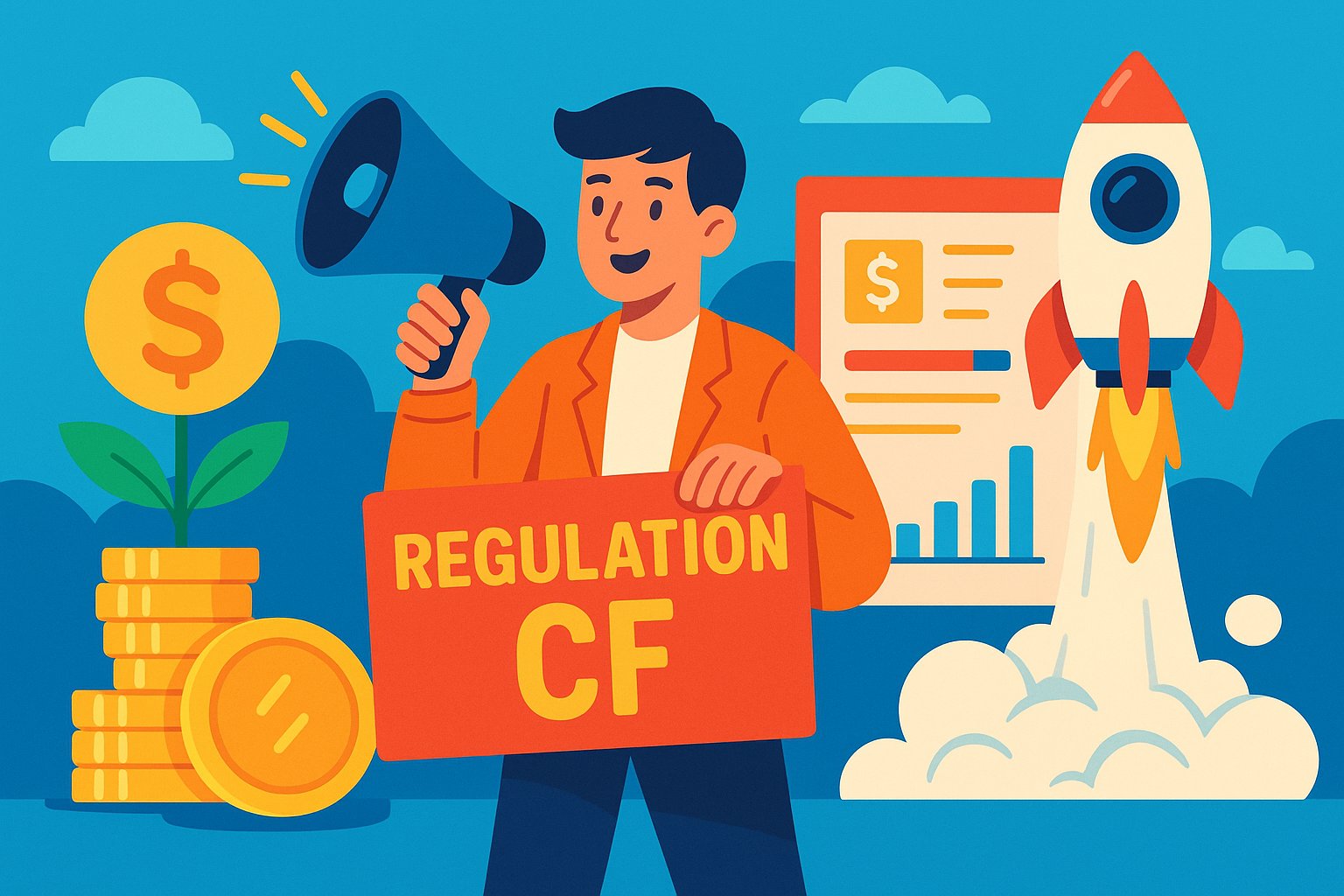Forging a Funding Milestone: The Power and Promise of the $5 Million Cap
Equity crowdfunding has revolutionized startup financing, tearing down barriers that once confined private capital to venture firms and angel networks. Central to this democratization is Regulation Crowdfunding (Reg CF), which empowers companies to raise up to $5 million per 12-month period from both accredited and non-accredited investors. For many entrepreneurs, hitting that $5 million ceiling represents a watershed moment: proof of broad-based support, a buoyant war chest for growth, and a compelling narrative for future backers. Yet the question lingers: Is $5 million enough to propel your startup from early promise to market leader?
In this expansive exploration, we’ll unpack the dynamics of raising to the Reg CF cap, evaluate startup capital requirements at various stages, spotlight strategies to ignite momentum and sustain traction, and examine what comes next when you’ve maxed out your crowdfunding window. Along the way, you’ll discover how legal guardrails shape your campaign, how to craft irresistible investor narratives, which platforms best suit a high-aiming raise, and how to balance ambition with pragmatism. By the end, you’ll be equipped with a strategic framework to decide whether hitting $5 million under Reg CF aligns with your long-term vision—or if you need to chart a multi-stage funding roadmap that taps additional sources of growth capital.
From $1 Million to $5 Million: The Evolution of Reg CF’s Ceiling
When the SEC first implemented Reg CF in 2016, the initial fundraising cap stood at $1.07 million, reflecting a cautious approach to opening private markets. By limiting annual raises, regulators prioritized investor protection, ensuring that retail backers would not overextend in speculative ventures. However, as crowdfunding platforms matured and issuers demonstrated consistent compliance and transparency, the SEC revisited this threshold. In March 2021, the cap quintupled to $5 million, heralding a new era of opportunity for growth-stage companies. This seismic change recognized that startups often require more substantial capital to scale operations, invest in talent, and accelerate go-to-market efforts—without immediately resorting to traditional venture rounds or debt financing.
The shift from a $1 million ceiling to $5 million did more than expand war chests; it altered investor psychology. For backers, the larger raise signified stronger issuer confidence and broader community buy-in. For founders, it validated the viability of crowdfunding as a primary, rather than supplemental, funding channel. Yet with great potential comes great responsibility: securing $5 million demands more rigorous campaign design, deeper legal diligence, and a marketing engine capable of attracting thousands of individual investors. Understanding the regulatory journey that led to this cap helps frame the balance between ambition and accountability that any $5 million Reg CF campaign must strike.
Charting Your Capital Needs: Does $5 Million Match Your Growth Plan?
Every startup’s capital requirements hinge on its stage of development, industry dynamics, and go-to-market ambitions. A software-as-a-service (SaaS) venture, for instance, may need funds to finalize a product roadmap, build a sales team, and scale customer support. Conversely, a hardware or consumer products company faces manufacturing, inventory, and distribution costs that can quickly accelerate burn rates. Begin by crafting a detailed financial model that forecasts expenses over 12 to 24 months: include headcount, technology infrastructure, marketing spend, operational overhead, and working capital reserves. Overlay this with revenue projections—whether subscription ARR, unit sales, or service fees—and identify the funding gap that your Reg CF raise must close.
In some cases, $5 million will cover a full growth cycle to product-market fit and initial profitability. In others, it may only extend runway by 12 to 18 months, necessitating follow-on financing. Founders often overestimate the speed at which revenue scales; real-world adoption curves can surprise even the most optimistic projections. By stress-testing your model—simulating slower customer acquisition, higher churn, or unexpected regulatory costs—you gauge whether $5 million delivers sustainable momentum or merely delays an inevitable capital crunch. A clear-eyed assessment ensures that you neither undershoot the Reg CF cap by playing it too safe nor overreach with unrealistic promises that erode founder credibility.
Navigating the Legal Labyrinth: Compliance Essentials for a $5 Million Raise
Raising millions under Reg CF requires meticulous attention to legal and regulatory requirements. The campaign begins with filing Form C (the offering statement) on the SEC’s EDGAR system, disclosing business plans, financial statements, capitalization tables, and risk factors. For raises between $1.07 million and $5 million, the SEC mandates reviewed or audited financial statements, as opposed to the simpler certified statements allowed below the previous lower cap. Engaging a reputable accounting firm early in your planning prevents last-minute surprises and secures clean financials that bolster investor trust.
State-level securities laws—Blue Sky regulations—also come into play. While Reg CF provides a federal preemption, many states require notice filings or fees on a state-by-state basis. Enlist securities counsel who can navigate these requirements, ensuring that all 50 states (plus D.C. and Puerto Rico, when applicable) grant offering exemptions or acknowledge your filing. Additionally, review your offering terms carefully: share class structures, valuation, voting rights, and investor protections like pro-rata rights or information rights. Legal clarity in your subscription agreements and operating documents not only safeguards compliance but also creates a frictionless experience for investors, encouraging participation in your landmark $5 million campaign.
Crafting an Irresistible Narrative: Storytelling at Scale
When courting thousands of individual investors, storytelling becomes your most potent tool. Unlike institutional capital—which often hinges on financial metrics and proprietary diligence—crowdfunding thrives on emotional resonance and community alignment. Your narrative should weave a compelling tapestry: the problem you’re solving, the personal journey of your founders, authentic customer success stories, and a bold vision for impact. Embed visual and multimedia elements—product demos, founder interviews, and customer testimonials—to create a richer investor experience.
At $5 million, you’re asking for substantial community buy-in, so be prepared to provide granular roadmaps: clear timelines for product milestones, market launches, and revenue targets. Offer transparent updates on channels like platform blogs, email newsletters, and live Q&A webinars. When thousands of backers invest, they expect real-time engagement; silence can breed doubt and derail momentum. By treating your campaign as a dynamic narrative rather than a static pitch deck, you cultivate a sense of collective ownership—transforming investors into passionate advocates who amplify your message across social media and personal networks.
The Marketing Engine: Amplifying Reach to Hit the Cap
Securing $5 million demands a multi-channel marketing strategy that extends far beyond your immediate network. Begin with your warm leads—friends, family, professional contacts, and customers—then expand outward through targeted digital campaigns. Leverage social media advertising on platforms like LinkedIn for B2B audiences or Instagram and Facebook for consumer products. Employ content marketing—thought leadership articles, podcasts, and webinars—to showcase your expertise and build credibility. Partnerships with relevant online communities and niche influencers can introduce your campaign to thousands of engaged prospects.
Consider creating a landing page outside your crowdfunding portal that captures email sign-ups for early campaign bird rights or exclusive previews. This pre-launch list fuels immediate traction on Day One—a critical indicator for platform algorithms and herd behavior. Use retargeting ads to re-engage visitors who clicked but did not invest, and deploy countdown timers as your campaign nears the final stretch to create urgency. At this scale, paid media budgets may run into tens of thousands of dollars, but when expertly executed, the return on investment can dwarf the spend by unlocking the social proof needed to breeze past the $5 million mark.
Choosing the Right Portal Partner: Platform Dynamics Matter
Not all crowdfunding portals are created equal. When your sights are set on the $5 million ceiling, platform selection warrants deep scrutiny. Examine each portal’s historical data: average raise sizes, success rates for high-ticket campaigns, and demographic breakdowns of investor communities. Some platforms specialize in tech startups with affluent networks, while others cater to consumer brands with engaged retail audiences. Fee structures also vary: portals typically charge a percentage of funds raised plus potential equity-for-service arrangements.
Evaluate each partner’s service offerings—do they provide marketing support, PR introductions, or campaign coaching? Do they offer SPV (Special Purpose Vehicle) mechanisms that bundle investors into a single entity for simplified cap table management? Explore their technology stack: real-time analytics dashboards, automated investor accreditation checks, and integrations with email marketing platforms. The right portal becomes more than a transaction conduit; it serves as a strategic ally that enhances your campaign’s visibility, investor experience, and operational efficiency—essential ingredients for transcending the $5 million threshold.
Stretch Goals vs. Realism: Balancing Ambition and Credibility
In the lexicon of crowdfunding, stretch goals are incremental funding milestones set above your initial target—think “If we raise $2 million, we’ll unlock Feature X; if we hit $3.5 million, we’ll add Service Y.” While stretch goals can galvanize existing investors to share the campaign more widely, they carry the risk of overpromising. When you aim for $5 million, investors expect each added million to translate into demonstrable value rather than nebulous enhancements.
To balance ambition with credibility, tie stretch goals to well-defined deliverables, budgets, and timelines. Quantify the impact of each incremental infusion: “An additional $500,000 unlocks our ability to hire two senior engineers by Q4,” or “Surpassing $4 million enables a nationwide pilot program with Retail Partner Z.” Clear articulation of stretch goal benefits transforms them from marketing gimmicks into tangible milestones that justify continued investment and mitigate skepticism.
Strategic Use of Proceeds: Maximizing Every Dollar
Raising capital is only half the battle; deploying it effectively determines whether $5 million truly moves the needle. Outline a use-of-proceeds plan that rings with both strategic logic and financial discipline. Allocate funds across key categories—product development, hiring, marketing, regulatory compliance, and working capital—and specify percentages or dollar amounts for each. For instance, earmarking 40 percent for engineering hires, 25 percent for go-to-market campaigns, and 35 percent for operational scalability conveys a prioritized roadmap.
Within each category, drill down further: in marketing, differentiate between customer acquisition channels (paid search vs. influencer partnerships); in hiring, specify roles critical to your next pivot (senior full-stack engineer vs. QA lead). Investors want to see that their funds will unlock specific accelerators rather than dissipate in generalized overhead. A meticulously detailed deployment plan also prepares you for post-close accountability, as backers will benchmark your actual spending against these projections and expect transparent reporting on variances and course corrections.
Cultivating Investor Relations: Beyond the Funding Round
Closing a $5 million Reg CF round marks a pivotal achievement, but maintaining investor trust requires an ongoing commitment to communication and accountability. Establish a reporting cadence—quarterly or bi-monthly updates via email or video—to share progress against milestones, financial performance, and emerging challenges. Invite backers to virtual events, customer demos, or Q&A sessions to reinforce their sense of community engagement.
Many startups incorporate investor councils—small groups of highly engaged backers who provide feedback on product features, market strategy, or expansion plans. This direct line of dialogue fosters loyalty, generates valuable insights, and elevates investors from passive financiers to active advocates. When the time comes for follow-on raises, these deeply engaged backers often lead the charge, providing both capital and vocal endorsements that attract institutional partners. By nurturing relationships well after the campaign close, you transform a one-time funding event into a sustained growth partnership.
The Hidden Costs: Dilution, Obligations, and Scrutiny
Maximizing raise size invites scrutiny—from regulators, platforms, and investors alike—and introduces potential downsides that founders must weigh. At $5 million, your cap table becomes populated with thousands of smaller shareholders, which can complicate future financing rounds and governance decisions.
Investors at different investment levels may demand varied protective provisions—pro rata rights, information rights, or even board observer seats—that add layers of administrative complexity. Additionally, larger raises attract deeper regulatory oversight, including more rigorous SEC review and heightened expectations around financial transparency.
Dilution is another byproduct: if you offer a significant equity stake to reach $5 million, you must balance immediate capital with the long-term ownership percentages you wish to retain for founders, employees, and institutional investors. Over-dilution can hamper incentive structures and create friction in subsequent private placements. Recognizing these hidden costs ensures that the allure of a full cap raise doesn’t overshadow the practical implications for your startup’s governance and future financing flexibility.
Beyond the Horizon: Charting the Next Funding Phases
For many startups, Reg CF serves as a launching pad rather than a permanent financial foundation. Once you near or hit your $5 million ceiling, planning for follow-on rounds becomes imperative. Options include Regulation A+, which permits raises up to $75 million and broad solicitation with audited financials, or Regulation D offerings—such as Rule 506(c)—that allow general solicitation to accredited investors. Traditional Series A institutional rounds may follow, leveraging your Reg CF momentum as social proof of market demand.
Mapping a multi-stage funding roadmap aligns capital milestones with growth targets: perhaps using Reg CF to validate product-market fit and build a loyal community, then transitioning to Reg A+ for aggressive expansion, and finally engaging VCs for deep pockets and strategic partnerships. Timing is critical—maintaining runway and investor confidence requires seamless transitions between each stage. By integrating your Reg CF strategy into a broader financing narrative, you convert a one-off raise into a ladder of growth capital, each rung reinforcing the next.
Is $5 Million Enough—or Just the Beginning?
Raising up to $5 million under Regulation Crowdfunding marks a remarkable achievement—a witness to community support, regulatory progress, and founder tenacity. But whether it’s enough depends on the unique contours of your business: your industry, capital intensity, scaling strategy, and long-term vision. For agile SaaS companies with capital-efficient models, $5 million can drive significant user growth, product innovation, and market leadership. For hardware or biotech ventures, it may only scratch the surface of R&D costs and manufacturing complexities.
Ultimately, hitting the cap should be viewed not as a finish line but as a strategic inflection point. It’s the moment when founders must pause, assess actual performance against projections, and chart the optimal path forward—whether that entails leveraging newly unlocked momentum into a Reg A+ piloting, cultivating institutional partnerships through Reg D, or conserving runway to achieve key milestones organically. With rigorous planning, authentic storytelling, disciplined execution, and a clear multi-stage funding roadmap, the $5 million Reg CF cap becomes a powerful springboard—one that propels your startup not only to its next financing round but toward lasting market success.




